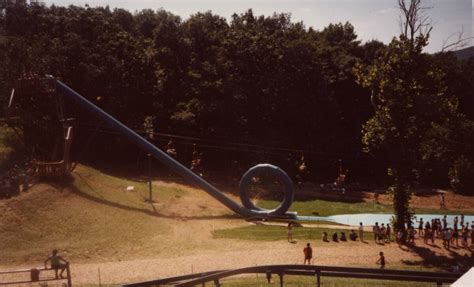
Action Park, the infamous New Jersey amusement park that became synonymous with danger and questionable safety standards, continues to fascinate and horrify 47 years after its initial opening, prompting reflection on its enduring, deadly legacy and the reasons behind its morbid appeal. Despite multiple injuries and at least six deaths connected to the park, its allure persists, fueled by nostalgia, dark humor, and a morbid curiosity about how such a perilous place ever existed.
Action Park, which originally opened in 1978, wasn’t just a park; it was a crucible of chaos, where patrons risked life and limb on attractions like the Cannonball Loop – a water slide so dangerous it was quickly shut down – and the wave pool, which earned the grim nickname “The Grave Pool.” The park’s lax oversight, coupled with undertrained and often underage staff, created an environment ripe for accidents. According to Andy Mulvihill, son of park founder Gene Mulvihill and author of “Action Park: Fast Times, Wild Rides & The Untold Story of a Dangerous Amusement Park,” the park operated under a unique set of rules, or lack thereof. “He had a very ‘act first, apologize later’ type of mentality,” Mulvihill said of his father, reflecting the freewheeling ethos that defined Action Park.
The park’s attractions, conceived with a disregard for safety, became legendary for all the wrong reasons. The Alpine Slide, a concrete track down a steep hill, resulted in countless abrasions and fractures. The Super Speedboats, prone to malfunctions, often left riders stranded in the middle of the park’s lake. And then there was the aforementioned Cannonball Loop, a fully enclosed water slide that riders were reportedly paid $100 to test – a testament to its perceived danger. These weren’t isolated incidents; accidents were a regular occurrence at Action Park, contributing to its reputation as the most dangerous amusement park in the world.
The reasons for Action Park’s lasting appeal are complex. Nostalgia plays a significant role for those who visited the park during its heyday. It represents a time of carefree summer days and youthful rebellion, where the thrill of danger was part of the experience. For others, the park’s story is a cautionary tale, a reminder of the consequences of unchecked ambition and disregard for safety. The park’s notoriety has also been amplified by documentaries, podcasts, and online communities dedicated to dissecting its history and sharing anecdotes of near-death experiences.
Action Park closed in 1996, weighed down by lawsuits and financial troubles. It reopened in 1998 under new ownership and a new name, Mountain Creek Waterpark, with a focus on safety and modern amusement park standards. However, the legend of Action Park continues to overshadow its successor, ensuring that its legacy of danger and mayhem endures. The story of Action Park is a uniquely American one, reflecting a cultural fascination with risk-taking, entrepreneurial spirit, and the dark side of nostalgia. It’s a story that continues to resonate, prompting us to question the line between thrill-seeking and reckless endangerment.
The enduring popularity of Action Park is also fueled by the internet age. Viral videos and online forums have amplified the park’s notoriety, introducing it to a new generation of thrill-seekers and morbidly curious individuals. The park’s story has become a meme, a symbol of unchecked ambition and disastrous consequences. This digital afterlife has ensured that Action Park remains a topic of conversation, even decades after its closure.
Furthermore, the park’s story taps into a deeper cultural fascination with disaster. We are drawn to stories of things gone wrong, whether it’s a plane crash, a natural disaster, or an amusement park plagued by accidents. These stories allow us to confront our own mortality and to contemplate the fragility of human life. Action Park, in its own peculiar way, offers a microcosm of this fascination, presenting a spectacle of chaos and near-death experiences that continues to captivate our imaginations.
The legacy of Action Park extends beyond its physical existence. It serves as a case study in risk management, corporate responsibility, and the ethical implications of amusement park design. The park’s history has been examined by legal scholars, safety experts, and business ethicists, all seeking to understand the factors that led to its disastrous track record. The lessons learned from Action Park have had a tangible impact on the amusement park industry, leading to stricter regulations and a greater emphasis on safety standards.
Moreover, Action Park’s story highlights the importance of accountability. While Gene Mulvihill was a charismatic and innovative entrepreneur, he was also criticized for his cavalier attitude towards safety and his willingness to cut corners. The lawsuits and financial troubles that eventually led to the park’s closure underscore the consequences of prioritizing profit over the well-being of customers. The story of Action Park serves as a cautionary tale for businesses in all industries, reminding them that ethical conduct and responsible practices are essential for long-term success.
The park’s cultural impact is undeniable. It has been the subject of documentaries, fictionalized accounts, and numerous articles and blog posts. The story of Action Park has become a part of American folklore, a cautionary tale about the dangers of unchecked ambition and the allure of forbidden thrills. Its name evokes a sense of both nostalgia and dread, reminding us of a time when safety regulations were lax and the pursuit of excitement often came at a high price.
In conclusion, Action Park’s deadly legacy continues to captivate us because it embodies a unique combination of nostalgia, dark humor, and cautionary lessons. It’s a story about risk-taking, entrepreneurial spirit, and the consequences of prioritizing profit over safety. The park’s enduring appeal lies in its ability to provoke a range of emotions, from amusement and nostalgia to horror and disbelief. It’s a story that reminds us of the importance of responsible governance, ethical conduct, and the enduring human fascination with danger. As Andy Mulvihill aptly stated, his father had a “act first, apologize later” mentality, which perfectly encapsulates the spirit that both built and ultimately destroyed Action Park. The echoes of its chaotic legacy continue to reverberate, serving as a reminder that some thrills are simply not worth the risk.
Frequently Asked Questions (FAQ):
1. What exactly was Action Park, and where was it located?
Action Park was an amusement park located in Vernon Township, New Jersey, which operated primarily from 1978 to 1996. It was known for its dangerous and poorly designed rides, lax safety standards, and a high number of injuries. The park featured a variety of attractions, including water slides, alpine slides, go-karts, and a wave pool, all of which contributed to its infamous reputation. It reopened under new ownership as Mountain Creek Waterpark in 1998.
2. How many deaths were associated with Action Park, and what were the main causes?
At least six deaths have been linked to Action Park during its original run. These deaths resulted from a variety of incidents, including drowning in the wave pool (“The Grave Pool”), ejection from the Alpine Slide causing head trauma, and cardiac arrest in the frigid waters of the Kayak Experience. The lack of adequate safety measures, undertrained staff, and risky ride designs all contributed to the fatal accidents.
3. What made Action Park so dangerous compared to other amusement parks?
Action Park stood out due to a combination of factors: poorly designed and untested rides (like the Cannonball Loop), insufficient safety measures, undertrained and often underage staff, and a generally lax attitude towards safety regulations. The park’s owner, Gene Mulvihill, had a reputation for prioritizing innovation and thrill over safety, creating an environment where accidents were almost inevitable. As his son Andy Mulvihill stated, his father had a “act first, apologize later” type of mentality.
4. Why does Action Park still have a following and continue to be talked about today?
Despite its tragic history, Action Park retains a strong following for several reasons. Nostalgia plays a significant role for those who visited the park during its operation, remembering it as a place of thrilling, albeit dangerous, summer adventures. The park’s notoriety has also been amplified by documentaries, podcasts, and online communities that dissect its history and share anecdotes of near-death experiences. Furthermore, the story of Action Park serves as a cautionary tale about the consequences of unchecked ambition and disregard for safety, making it a compelling and enduring topic of conversation. The dark humor associated with its absurdly dangerous rides also contributes to its morbid appeal.
5. What impact did Action Park have on the amusement park industry and safety regulations?
Action Park’s disastrous safety record led to increased scrutiny of amusement park regulations and safety standards. The numerous lawsuits and financial troubles that ultimately led to the park’s closure highlighted the importance of accountability and responsible risk management. As a result, amusement park operators have become more diligent in implementing safety measures, conducting thorough ride inspections, and training staff to handle emergencies. The story of Action Park serves as a reminder of the potential consequences of prioritizing profit over the well-being of customers, influencing the industry to prioritize safety in the design and operation of amusement parks.
Further Elaboration & Contextual Details (Expanding on the Core Information):
The Mulvihill Factor: Innovation and Recklessness:
Gene Mulvihill, the founder of Action Park, was both a visionary and a controversial figure. He possessed an undeniable entrepreneurial spirit and a knack for creating innovative attractions. However, his approach to safety was often criticized as reckless and negligent. Mulvihill’s philosophy seemed to prioritize thrill and excitement above all else, leading to the creation of rides that were inherently dangerous.
His lack of formal engineering training contributed to the park’s problems. He often designed and built attractions without proper testing or safety evaluations. This resulted in rides that were prone to malfunctions and presented significant risks to riders. The Cannonball Loop, for example, was conceived as a daring and innovative water slide, but its design was flawed, and it posed a serious threat to the safety of anyone who dared to ride it.
Mulvihill’s management style also played a role in the park’s dangerous environment. He often delegated responsibility to inexperienced and undertrained staff, many of whom were teenagers. These employees lacked the knowledge and skills necessary to operate the rides safely and to respond effectively to emergencies.
The Rides of Ruin: A Catalog of Calamity:
A closer look at some of Action Park’s most notorious rides reveals the extent of its disregard for safety:
-
The Cannonball Loop: This infamous water slide was a fully enclosed loop that riders attempted to navigate. However, the G-forces generated by the loop were so intense that many riders suffered injuries, including scrapes, bruises, and even nosebleeds. The ride was quickly shut down after only a few weeks of operation, but its legend lived on as a symbol of Action Park’s recklessness.
-
The Alpine Slide: This concrete track down a steep hill was another source of countless injuries. Riders controlled their speed with a handbrake, but many failed to do so effectively, resulting in crashes and abrasions. The lack of padding or other safety features made the Alpine Slide particularly dangerous.
-
The Wave Pool (The Grave Pool): This deceptively named attraction was responsible for multiple deaths. The powerful waves created by the pool could overwhelm even experienced swimmers, and the undertow made it difficult to escape. The pool’s dark waters and frequent rescues earned it the nickname “The Grave Pool.”
-
The Super Speedboats: These small motorboats were prone to mechanical failures, often leaving riders stranded in the middle of the park’s lake. The boats were also difficult to control, leading to collisions and other accidents.
-
The Kayak Experience: The frigid, murky water of the “Kayak Experience” was not only unpleasant but also dangerous. The sudden immersion in cold water could trigger cardiac arrest, as happened to one unfortunate visitor.
The Legal Aftermath: Lawsuits and Liability:
The numerous accidents and deaths at Action Park resulted in a wave of lawsuits against the park and its owner. These lawsuits alleged negligence, recklessness, and failure to provide a safe environment for visitors. The financial burden of these lawsuits, combined with declining attendance and increased insurance costs, eventually led to the park’s closure.
The legal battles surrounding Action Park also had a broader impact on the amusement park industry. They highlighted the importance of clear liability waivers, thorough safety inspections, and adequate insurance coverage. As a result, amusement parks across the country have become more diligent in addressing these issues.
The Cultural Resonance: Nostalgia and Cautionary Tales:
Action Park’s enduring appeal is rooted in a complex mix of nostalgia and cautionary lessons. For those who visited the park during its heyday, it represents a time of carefree summer days and youthful rebellion. The thrill of danger was part of the experience, and the park’s chaotic atmosphere created a sense of camaraderie among visitors.
However, Action Park’s story is also a cautionary tale about the consequences of unchecked ambition and disregard for safety. It serves as a reminder that the pursuit of excitement should not come at the expense of human life. The park’s history has been examined by legal scholars, safety experts, and business ethicists, all seeking to understand the factors that led to its disastrous track record.
The park’s cultural impact is undeniable. It has been the subject of documentaries, fictionalized accounts, and numerous articles and blog posts. The story of Action Park has become a part of American folklore, a cautionary tale about the dangers of unchecked ambition and the allure of forbidden thrills.
The Legacy Continues: Mountain Creek Waterpark:
After closing in 1996, Action Park was eventually reopened under new ownership as Mountain Creek Waterpark. The new park has made significant efforts to improve safety standards and to distance itself from its predecessor’s reputation. However, the legend of Action Park continues to overshadow Mountain Creek Waterpark, ensuring that its legacy of danger and mayhem endures.
The contrast between the two parks highlights the evolution of amusement park safety over the past few decades. Mountain Creek Waterpark represents a modern approach to amusement park design, with a focus on risk management and customer well-being. Action Park, on the other hand, represents a bygone era of lax regulations and a more cavalier attitude towards safety.
Action Park as a Microcosm of American Culture:
The story of Action Park is uniquely American, reflecting several key aspects of the nation’s culture:
-
Risk-Taking and Entrepreneurial Spirit: Gene Mulvihill’s willingness to take risks and his entrepreneurial drive are characteristic of the American spirit. He was a bold and innovative businessman who was not afraid to challenge conventional wisdom.
-
The Pursuit of Thrills: Americans have a long-standing fascination with thrills and excitement. Action Park tapped into this desire by offering a range of rides that were designed to push the limits of human experience.
-
The Dark Side of Nostalgia: Nostalgia can be a powerful force, but it can also blind us to the darker aspects of the past. Action Park’s enduring appeal is partly due to nostalgia, but it’s important to remember the real dangers that existed at the park.
-
Accountability and Responsibility: The lawsuits and financial troubles that eventually led to Action Park’s closure underscore the importance of accountability and responsibility. Businesses must be held accountable for their actions, and they must prioritize the safety and well-being of their customers.
In conclusion, Action Park’s deadly legacy continues to fascinate and horrify because it embodies a unique combination of nostalgia, dark humor, and cautionary lessons. It’s a story about risk-taking, entrepreneurial spirit, and the consequences of prioritizing profit over safety. The park’s enduring appeal lies in its ability to provoke a range of emotions, from amusement and nostalgia to horror and disbelief. It’s a story that reminds us of the importance of responsible governance, ethical conduct, and the enduring human fascination with danger.









